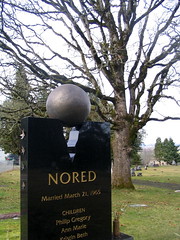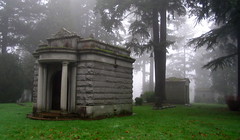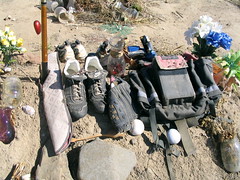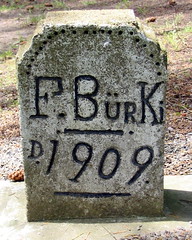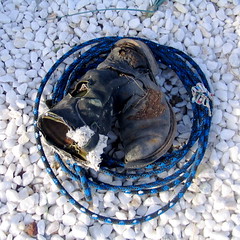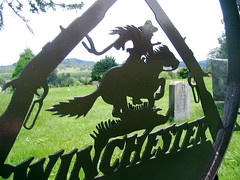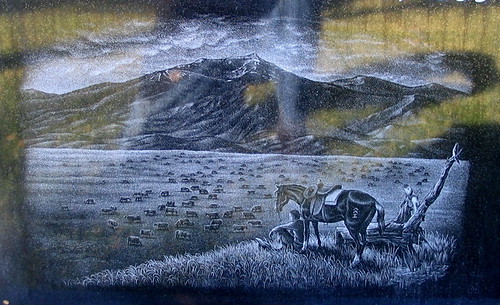
Stew and I went back a long ways. He was two years older than me — that would put him in the class of ‘57 — but that’s close enough. We were both pre-baby boomers. We were both radical revolutionaries. Stew was known and loved by everyone. I’m loved, I’m told, by my family.
Hey! A love’s a love.
Stew never heard of me. I’m sure he never heard of my claim to fame, either, and, unfortunately, neither have I. Just as well, I suppose; I would have squandered it. I’ll tell you one day about my groupie, but not now.
That I ran across Stew’s grave in a tiny, hidden Jewish cemetery here in Portland should not have surprised me, because I knew he’d died here recently. I hadn’t thought that he was Jewish, but that doesn’t surprise me, either. Knowing he was Jewish and knowing who tends to end up in Havurah Shalom, the hidden cemetery, could have enabled me to put two and two together. I was not abled and hence didn’t put two and two together until I got home and downloaded my pictures and looked at his tombstone again: “Stew Albert, 1939-2006, Husband and father/ Mentor and friend/ Scholar and poet/ Revolutionary and rabbinic inspiration.”
“Revolutionary and rabbinic inspiration?” Why, that’s Stew Albert, I blurted out loud, and began to cry. It was as if I suddenly run across the grave of a friend whom I hadn’t known had died. It wasn’t just Stew laying there. It was part of my life. Jesus Christ, I muttered, has it come to this?
Stew Albert (check out his
site) was a cofounder of the Yippies along with Jerry Rubin and Abbie Hoffmann, and he raged against the machine until the very end. His signature post remains: “My politics have not changed.” While Stew was disrupting the Chicago Convention in 1968, I was getting arrested for running the “underground” press in Minneapolis; and, if we never met, our lives ran somewhat in parallel, if in no other fashion than we both ended up in Portland. They stopped running in parallel a bit ago when Stew up and died, which is how I came to find his grave in Havurah Shalom.
Finding Stew is no easy task. First one has to find Havurah Shalom Cemetery. The intersection where it is next to has been rearranged since I was there last and it took me two whacks to get it correct. It’s behind the Sylvan Hill Church at the Sylvan exit from Hwy. 26 at the crest of the hill before plunging towards Portland. Southeast corner. But it’s not as simple as it sounds.
Regardless, when you find the church, find its parking lot around back. (There is no parking around front, so that part is easy.) At the far back corner of the parking lot you’ll notice gates leading through the hedge. If you pass by the gates you’ll be greeted by a small sign telling you that you are in Jones Pioneer Cemetery, one of fourteen pioneer cemeteries under Metro’s (a Portland, OR, area regional government) jurisdiction. Jones doesn’t have a lot of monuments, and many of them are scattered in an almost unfriendly fashion away from each other under a dark canopy of hardwoods, with a denser clustering of newer graves higher on the hill where the trees thin out or disappear; but the largest grouping of graves is in the farthest away corner yet, filled with light and detailed from the rest of the cemetery by a low hedge: Havurah Shalom, a small cemetery devoted to Jewish civic activists.

Havurah Shalom, like most if not all Jewish cemeteries, is associated with a congregation with, as is usually the case, the same name. It is a Reconstructionist Jewish community, which means that it emphasizes evolutionary social development and community politics. Where else are you going to bury a guy like Stew? You don’t even have to be Jewish to belong, so long as you don’t mind eating blintzes and knishes.

Given that cemeteries reflect their communities, the particulars of Havurah Shalom describe an unusual and enriched gathering of souls. Havurah Shalom is not the only Jewish cemetery within a Metro cemetery, the East Side Jewish Community of Portland relatively recently opened up a small cemetery within Troutdale’s Douglass Cemetery, but Havurah Shalom set the precedent and the standards. Nothing announces Havurah Shalom, there is no signage, but that you’re suddenly in a Jewish enclave is evident as soon as you reach the cluster of monuments. Many of the stones, of course, are emblazoned with the Star of David, but if you look around you’ll notice that many of them have acquired small piles of pebbles brought by mourners and that an unusual number of the stones are natural. But even more noticeable is the nature of the epitaphs, which tend to reflect the community activism of their members. Indeed, some stones go so far as to state that their person was an “activist,” plain and simple. This is not a gaudy community, but it is straight talking. Restraint and dignity reign. Stew has a lot of good company.

Havurah Shalom is typical of Portland Jewish cemeteries in being hidden. There are five other Jewish cemeteries in the Portland area, besides the two in Metro cemeteries, and all five have live-in surveillance families in on-premise housing; and four are located where you’ll never accidentally drive by them (Beth Israel at the top of Burlingame is quite noticeable). The Jews have learned some hard lessons about vandalism and have taken the most surefire method available for dealing with it. East Side and Havurah Shalom try to hide in plain sight, as it were.
Jewish cemeteries are not the only ones where religion and ethnicity are intertwined, but no Christian church cemetery ties the two so closely together. One could argue that, say, Saint Wenceslaus Cemetery in St. Helens is an example of a Christian ethnic cemetery, but nothing restricts Christianity to the Bohemians, as Judaism does to the Jewish people (whomever they might be, which is, admittedly, a slippery slope). Joining a Reconstructionist Jewish community will not make one Jewish. But if you were to start a stroll through Oregon’s ethnic cemeteries, Jewish cemeteries, because of their clarity, are a good place to begin; and if you’re going to start with Jewish cemeteries, Havurah Shalom is as good a choice as any. The others are equally interesting, and we’ll get to them by-and-by, but for my money this is a high point of our culture: it shows the best of who we can be. It’s American, it’s inclusive, it’s distinctive, it’s embracing. You’ll even note, as you walk through Jones Pioneer approaching Havurah Shalom, that, as the light expands and the newer graves begin to appear, they too, if not directly a part of Havurah Shalom, reflect its spirit. Conscience, peace, and dignity find shelter here. It is a good place to die.

A set of photos devoted to Havurah Shalom can be found on my Flickr
site. A link from each photo will take you to a map and aerial photo of the cemetery location.
The Dreaded Introduction
A bit of introduction here that no one will read; but this is, after all, blog #1 and you might want an idea of where we’re going.
We’re going to the cemetery, Oregon cemeteries, for the most part, but without restrictions. Along the way we’ll find out what kind of cemeteries there are, how they function, and how they got there. In the process we’ll find out who lives in Oregon — or wherever — and what they think about life and family. We’ll learn about place and how place affects people. We’ll learn about how society is changing its view of death and that society has always been changing its views. We’ll see how the cemetery industry was born, how it was shaped, and what forces currently move it.
There is no more intimate part of life than death. It’s the other bookend. As Benjamin Franklin observed two-hundred years ago: if you want to know a people, visit their cemeteries. He didn’t say visit their watering holes or subway stations. We’ve spent the last several years finding out just who lives in Oregon. We’ve been to their cemeteries. Not all of them, we’re still working on, in particular, the southwest quadrant and big chunks of Eastern Oregon, but we’ve dropped in on close to 500 Oregon cemeteries, plus another sixty or seventy from elsewhere (we’re staring to prowl Washington). You can take a virtual tour of them all by yourself at my
site. Over here on the blog we’ll talk about what it all means and where the fun stuff can be found.
OUR GOAL(Oh boy, this is where is gets heavy.)
Cemeteries are a sort of wiki-place where the art and history of a community are on public display and to which everyone can contribute. There are no curators or academicians to decide what goes and what doesn’t. Only the community mores regulate that. (And we’ll see how well they succeed.) Before there were parks, there were cemeteries. People flocked to them by the tens of thousands. They had to have traffic cops on the weekends. They had to have rules about who could ride their horse into the cemetery and who couldn’t. In fact, cemetery visiting became so popular that the big-name cemetery designer of his day, a guy by the name of Frederick Law Olmsted, finally said, hey, let’s build a cemetery, but without the bodies. People could still come by the thousands but the upkeep would be infinitely simpler. Let’s, he said, build a park.
Well, they did build parks, and slowly people stopped hanging out in cemeteries. Soon all that art and history was being built, but nobody was visiting; they were all down at Central Park.
We’d like to reverse that trend. We don’t expect cemeteries to replace parks, nor do we suggest planting stiffs all through them (green burials notwithstanding), but we do think cemeteries are worth returning to their former glory as fun and entertaining places to visit. We like the spirit of places like Camp Polk Cemetery, which is riddled with fire pits and handmade benches. We’d like you to come out and visit your local cemeteries, and meet your neighbors in the process.
If you go, we’ll see you there.










